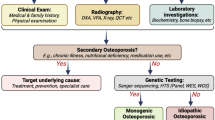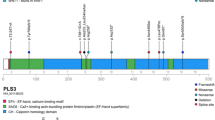Abstract
Homocystinuria and Marfan syndrome represent distinct genetic conditions that share phenotypically similar skeletal features. An overview of the current understanding of genetic and physiologic contributing to the etiology of these conditions is summarized. The focus of this review is to explore the present understanding of the pathophysiology of Marfan syndrome and homocystinuria relative to the occurrence of osteoporosis in both conditions. Osteoporosis has been reported in association with homocystinuria. However, evidence supporting an association of osteoporosis with Marfan syndrome is equivocal and sources of ambiguity are critically reviewed. Advisability and approaches to bone mineral density monitoring in patients with Marfan syndrome or homocystinuria to inform clinical management are discussed. Finally, future research foci are proposed which will improve understanding of association of osteoporosis with Marfan syndrome or homocystinuria.



Similar content being viewed by others
References
Dietz HC, Cutting GR, Pyeritz RE, et al. Marfan syndrome caused by a recurrent de novo missense mutation in the fibrillin gene. Nature. 1991;352:337–9.
Pyeritz RE, McKusick VA. The Marfan syndrome: diagnosis and management. N Engl J Med. 1979;300(14):772–7.
De Paepe A, Devereux RB, Dietz HC, Hennekam RC, Pyeritz RE. Revised diagnostic criteria for the Marfan syndrome. Am J Med Genet. 1996;62:417–26.
Shores J, Berger KR, Murphy EA, Pyeritz RE. Progression of aortic dilatation and the benefit of long-term beta-adrenergic blockade in Marfan’s syndrome. N Engl J Med. 1994;330:1335–41.
Neptune ER, Frischmeyer PA, Arking DE, et al. Dysregulation of TGF-beta activation contributes to pathogenesis in Marfan syndrome. Nat Genet. 2003;33:407–11.
Carter N, Duncan E, Wordsworth P. Bone mineral density in adults with Marfan syndrome. Rheumatology (Oxford). 2000;39:307–9.
Giampietro PF, Peterson M, Schneider R, et al. Assessment of bone mineral density in adults and children with Marfan syndrome. Osteoporos Int. 2003;14:559–63.
Gray JR, Bridges AB, Mole PA, Pringle T, Boxer M, Paterson CR. Osteoporosis and the Marfan syndrome. Postgrad Med J. 1993;69:373–5.
Kohlmeier L, Gasner C, Bachrach LK, Marcus R. The bone mineral status of patients with Marfan syndrome. J Bone Miner Res. 1995;10:1550–5.
Kohlmeier L, Gasner C, Marcus R. Bone mineral status of women with Marfan syndrome. Am J Med. 1993;95:568–72.
Le Parc JM, Plantin P, Jondeau G, Goldschild M, Albert M, Boileau C. Bone mineral density in sixty adult patients with Marfan syndrome. Osteoporos Int. 1999;10:475–9.
Moura B, Tubach F, Sulpice M, et al. Bone mineral density in Marfan syndrome. A large case-control study. Joint Bone Spine. 2006;73:733–5.
Tobias JH, Dalzell N, Child AH. Assessment of bone mineral density in women with Marfan syndrome. Br J Rheumatol. 1995;34:516–9.
Carson N, Raine D. Inherited disorders of sulfur metabolism. Edinburgh: Churchill Livingstone; 1971.
Giampietro PF, Peterson MGE, Schneider R, et al. Bone mineral density determinations by dual-energy X-ray absorptiometry-some factors which affect the measurement. HSSJ. 2007;3:89–92.
Green MC, Sweet HO, Bunker LE. Tight-skin, a new mutation of the mouse causing excessive growth of connective tissue and skeleton. Am J Pathol. 1976;82:493–512.
Siracusa LD, McGrath R, Ma Q, et al. A tandem duplication within the fibrillin 1 gene is associated with the mouse tight skin mutation. Genome Res. 1996;6:300–13.
Barisic-Dujmovic T, Boban I, Adams DJ, Clark SH. Marfan-like skeletal phenotype in the tight skin (Tsk) mouse. Calcif Tissue Int. 2007;81:305–15.
Mudd S, Levy H, Skovby F (1989) Disorders of trans-sulfuration. In: Scriver C, Beaudet A, Sly W, editors. The metabolic basis of inherited disease. 6th ed. New York: McGraw-Hill; 1989. 693 p.
Tada K, Tateda H, Arashima S, et al. Follow-up study of a nation-wide neonatal metabolic screening program in Japan. A collaborative study group of neonatal screening for inborn errors of metabolism in Japan. Eur J Pediatr. 1984;142:204–7.
Whiteman PD, Clayton BE, Ersser RS, Lilly P, Seakins JW. Changing incidence of neonatal hypermethioninaemia: implications for the detection of homocystinuria. Arch Dis Child. 1979;54:593–8.
Doherty LB, Rohr FJ, Levy HL. Detection of phenylketonuria in the very early newborn blood specimen. Pediatrics. 1991;87:240–4.
Naughten ER, Yap S, Mayne PD. Newborn screening for homocystinuria: Irish and world experience. Eur J Pediatr. 1998;157(Suppl 2):S84–7.
Walter JH, Wraith JE, White FJ, Bridge C, Till J. Strategies for the treatment of cystathionine beta-synthase deficiency: the experience of the Willink Biochemical Genetics Unit over the past 30 years. Eur J Pediatr. 1998;157(Suppl 2):S71–6.
Yap S, Naughten E. Homocystinuria due to cystathionine beta-synthase deficiency in Ireland: 25 years’ experience of a newborn screened and treated population with reference to clinical outcome and biochemical control. J Inherit Metab Dis. 1998;21:738–47.
Barber G, Spaeth G. Pyridoxine therapy in homocystinuria. Lancet. 1967;1:337.
Kraus JP, Janosik M, Kozich V, et al. Cystathionine beta-synthase mutations in homocystinuria. Hum Mutat. 1999;13:362–75.
Wilcken DE, Wilcken B, Dudman NP, Tyrrell PA. Homocystinuria—the effects of betaine in the treatment of patients not responsive to pyridoxine. N Engl J Med. 1983;309:448–53.
Brenton DP. Skeletal abnormalities in homocystinuria. Postgrad Med J. 1977;53:488–96.
McKusick V. Heritable disorders of connective tissue. St. Louis: C V. Mosby; 1966.
Schedewie H, Willich E, Grobe H, Schmidt H, Muller KM. Skeletal findings in homocystinuria: a collaborative study. Pediatr Radiol. 1973;1:12–23.
Parrot F, Redonnet-Vernhet I, Lacombe D, Gin H. Osteoporosis in late-diagnosed adult homocystinuric patients. J Inherit Metab Dis. 2000;23:338–40.
Mudd SH, Skovby F, Levy HL, et al. The natural history of homocystinuria due to cystathionine beta-synthase deficiency. Am J Hum Genet. 1985;37:1–31.
Lubec B, Fang-Kircher S, Lubec T, Blom HJ, Boers GH. Evidence for McKusick’s hypothesis of deficient collagen cross-linking in patients with homocystinuria. Biochim Biophys Acta. 1996;1315:159–62.
McLean RR, Jacques PF, Selhub J, et al. Homocysteine as a predictive factor for hip fracture in older persons. N Engl J Med. 2004;350:2042–9.
van Meurs JB, Dhonukshe-Rutten RA, Pluijm SM, et al. Homocysteine levels and the risk of osteoporotic fracture. N Engl J Med. 2004;350:2033–41.
Herrmann M, Kraenzlin M, Pape G, Sand-Hill M, Herrmann W. Relation between homocysteine and biochemical bone turnover markers and bone mineral density in peri- and post-menopausal women. Clin Chem Lab Med. 2005;43:1118–23.
Lumbers M, New SA, Gibson S, Murphy MC. Nutritional status in elderly female hip fracture patients: comparison with an age-matched home living group attending day centres. Br J Nutr. 2001;85:733–40.
Reynolds TM, Marshall PD, Brain AM. Hip fracture patients may be vitamin B6 deficient. Controlled study of serum pyridoxal-5′-phosphate. Acta Orthop Scand. 1992;63:635–8.
Villadsen MM, Bunger MH, Carstens M, Stenkjaer L, Langdahl BL. Methylenetetrahydrofolate reductase (MTHFR) C677T polymorphism is associated with osteoporotic vertebral fractures, but is a weak predictor of BMD. Osteoporos Int. 2005;16:411–6.
Dodds RA, Catterall A, Bitensky L, Chayen J. Abnormalities in fracture healing induced by vitamin B6-deficiency in rats. Bone. 1986;7:489–95.
Rauch F, Plotkin H, Dimeglio L, et al. Fracture prediction and the definition of osteoporosis in children and adolescents: the ISCD 2007 pediatric official positions. J Clin Densitom. 2008;11:22–8.
Acknowledgments
The authors would like to acknowledge the assistance of the staff of the Office of Scientific Writing Publication for their assistance in the preparation of this manuscript, with special thanks to Michelle Wellsandt and Marie Fleisner for their help with formatting of the figures and tables.
Author information
Authors and Affiliations
Corresponding author
Rights and permissions
About this article
Cite this article
Giampietro, P.F., Peterson, M. & Raggio, C.L. Alterations in Bone Mineral Density in Marfan Syndrome and Homocystinuria. Clinic Rev Bone Miner Metab 6, 46–52 (2008). https://doi.org/10.1007/s12018-008-9018-2
Published:
Issue Date:
DOI: https://doi.org/10.1007/s12018-008-9018-2




